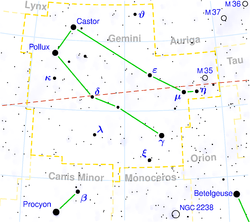Epsilon Geminorum
| Data pengamatan Epos J2000 Ekuinoks J2000 | |
|---|---|
| Rasi bintang | Gemini |
| Asensio rekta | 06j 43m 55.92626d[1] |
| Deklinasi | +25° 07′ 52.0515″[1] |
| Magnitudo tampak (V) | +3,06[2] |
| Ciri-ciri | |
| Kelas spektrum | G8 Ib[3] |
| Indeks warna U−B | +1,46[4] |
| Indeks warna B−V | +1,40[4] |
| Astrometri | |
| Kecepatan radial (Rv) | +8.09 ± 0.14[5] km/s |
| Gerak diri (μ) | RA: –5,57[1] mdb/thn Dek.: −12,36[1] mdb/thn |
| Paralaks (π) | 3,86±0,17[1] mdb |
| Jarak | 840 ± 40 tc (260 ± 10 pc) |
| Magnitudo mutlak (MV) | –3,90[6] |
| Detail | |
| Massa | 19,2 ± 0,1[7] M☉ |
| Radius | 140 ± 35[3] R☉ |
| Luminositas | 8.500[2] L☉ |
| Gravitasi permukaan (log g) | 0,88 ± 0,05[8] |
| Suhu | 4.662 ± 36[8] K |
| Metalisitas [Fe/H] | 0,15 ± 0,07[8] |
| Kecepatan rotasi (v sin i) | 8,7 ± 1,0[5] km/s |
| Usia | 8,3 ± 0,1[7] megatahun |
| Penamaan lain | |
| Referensi basis data | |
| SIMBAD | data |
Epsilon Geminorum (ε Gem / ε Geminorum) adalah salah satu bintang di rasi Gemini. Posisinya berada pada "kaki" dari salah satu si kembar Castor. Bintang ini memiliki magnitudo tampak +3,06.[2] Jarak bintang ini dari bumi adalah 913 tahun cahaya dan merupakan bintang supraraksasa kelas G8 Ib,[3] dengan diameter 150 kali Matahari.
Etimologi[sunting | sunting sumber]
Bintang ini memiliki nama tradisional Mebsuta (kadang-kadang disebut Melboula atau Melucta). Nama ini berasal dari bahasa Arab, dimana bersama Mekbuda (Zeta Geminorum) merupakan "cakar singa" Mebsuta berasal dari kata yang berarti "cakar yang maju". Nama lainnya untuk bintang ini adalah:
| nama lain | asal bahasa | arti |
|---|---|---|
| 井宿五 / Jǐngsuwǔ | China | bintang kelima di rasi Sumur[9] |
Lokasi[sunting | sunting sumber]

Referensi[sunting | sunting sumber]
- ^ a b c d e van Leeuwen, Floor (November 2007), "Validation of the new Hipparcos reduction", Astronomy and Astrophysics, 474 (2): 653–664, arXiv:0708.1752v1
 , Bibcode:2007A&A...474..653V, doi:10.1051/0004-6361:20078357 Note: see VizieR catalogue I/311.
, Bibcode:2007A&A...474..653V, doi:10.1051/0004-6361:20078357 Note: see VizieR catalogue I/311.
- ^ a b c Mallik, Sushma V. (December 1999), "Lithium abundance and mass", Astronomy and Astrophysics, 352: 495–507, Bibcode:1999A&A...352..495M
- ^ a b c Nordgren, Tyler E.; et al. (December 1999), "Stellar Angular Diameters of Late-Type Giants and Supergiants Measured with the Navy Prototype Optical Interferometer", The Astronomical Journal, 118 (6): 3032–3038, Bibcode:1999AJ....118.3032N, doi:10.1086/301114
- ^ a b Johnson, H. L.; et al. (1966), "UBVRIJKL photometry of the bright stars", Communications of the Lunar and Planetary Laboratory, 4 (99): 99, Bibcode:1966CoLPL...4...99J
- ^ a b De Medeiros, J. R.; et al. (November 2002), "A catalog of rotational and radial velocities for evolved stars. II. Ib supergiant stars" (PDF), Astronomy and Astrophysics, 395: 97–98, Bibcode:2002A&A...395...97D, doi:10.1051/0004-6361:20021214
- ^ Park, Sunkyung; Kang, Wonseok; Lee, Jeong-Eun; Lee, Sang-Gak (2013). "Wilson-Bappu Effect: Extended to Surface Gravity". The Astronomical Journal. 146 (4): 73. arXiv:1307.0592
 . Bibcode:2013AJ....146...73P. doi:10.1088/0004-6256/146/4/73.
. Bibcode:2013AJ....146...73P. doi:10.1088/0004-6256/146/4/73.
- ^ a b Tetzlaff, N.; Neuhäuser, R.; Hohle, M. M. (January 2011), "A catalogue of young runaway Hipparcos stars within 3 kpc from the Sun", Monthly Notices of the Royal Astronomical Society, 410 (1): 190–200, arXiv:1007.4883
 , Bibcode:2011MNRAS.410..190T, doi:10.1111/j.1365-2966.2010.17434.x
, Bibcode:2011MNRAS.410..190T, doi:10.1111/j.1365-2966.2010.17434.x
- ^ a b c Wu, Yue; et al. (January 2011), "Coudé-feed stellar spectral library - atmospheric parameters", Astronomy and Astrophysics, 525: A71, arXiv:1009.1491
 , Bibcode:2011A&A...525A..71W, doi:10.1051/0004-6361/201015014
, Bibcode:2011A&A...525A..71W, doi:10.1051/0004-6361/201015014
- ^ salah satu rasi bintang menurut bangsa Cina

